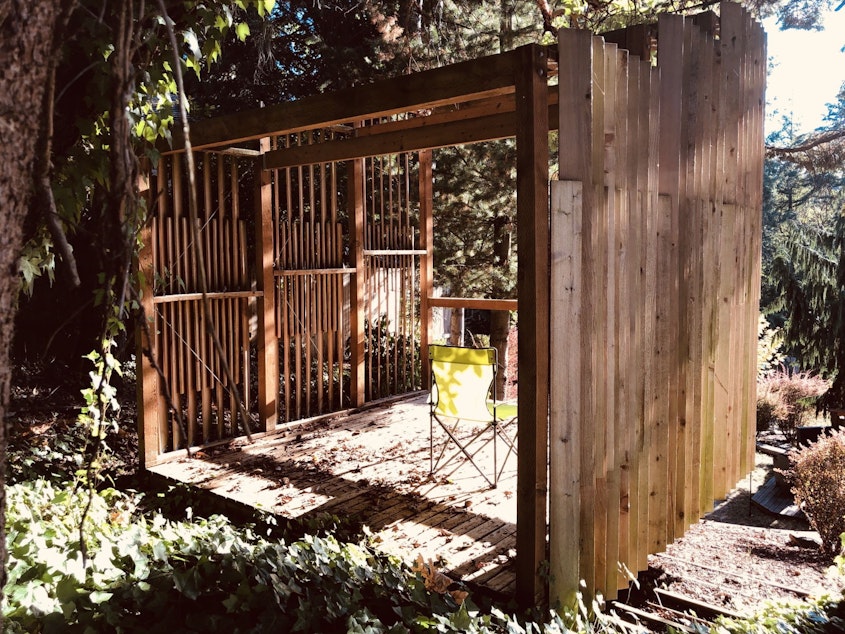No longer chained to desks, office workers pick up new habits

Remote work has given us control over how, where and when we work. That could change offices forever.
If you’ve worked in a modern office building, you’ve probably worked in an open office. That means most workers don’t get their own private room; they get a desk or maybe a cubicle underneath an acoustic ceiling tiles with those fluorescent lights.
All around are distractions – coworkers on phones, standup meetings, birthday celebrations, enticing plates of doughnuts in the office kitchen.
Now, with many of us working from home, some are rethinking that open office design.
Architect Andrea Vanecko said people discover freedom in college. There are no parents to boss you around, so you manage your own time.
“You go to the library and study for two hours, and then you go to the café and get some energy, and then you go back to your apartment," Vanecko said. "You decide when you’re going to work, where and what kind of environment you need. So you’re very self aware in terms of your own productivity.”
Sponsored
And then, Vanecko said, after college, comes the office job. Someone sits you down and says, “You’re gonna sit right here for eight hours and be productive.”
A sort of amnesia sets in as you grind through work days beneath unrelenting fluorescent lights. You forget how to control your environment, how to take walks when needed. How to change your location, to keep your energy up.
Vanecko and her colleague Ryan Mullenix, who both work at the Seattle architecture firm NBBJ, call this phenomenon “learned helplessness.”
“It’s essentially about the loss of control, which is the pure definition of stress," Mullenix said. "When I can’t control something, I’m stressed.
"We’ve created these environments where you don’t get to control anything. I don’t get to control where I sit, I don’t get to control the light, I don’t get to control the acoustics. I don’t get to control who I sit next to, for the most part.”
Sponsored
It’s not that open offices are all bad. They're transparent: It's easy to communicate across cubicles, which makes it easier to collaborate in teams. Sometimes we need that. After all, we are social animals.
But it’s the ubiquity of open offices that’s oppressive. They’re everywhere. And unless you’re a manager with your own private office, you can’t escape them.
Until Covid sent us all home.
And now, these architects say many people working from home are re-learning how to take control of their own environment.
“As you move through your day at home, you probably do move around more,” Vanecko said.
Sponsored
Maybe it’s as simple as moving from a table to a comfortable chair, or closing a bedroom door, to cut down on interruptions from kids, or opening a window, or taking a walk.
“At home, you know what it is that you need to do, and you just go do it,” Mullenix said.
And when workers return to the office, after the pandemic, these architects say workers will expect to retain some of the habits they’ve developed while working from home.
Related: Starbucks HQ will take a pandemic gap year to rethink work
Companies will need to make some changes, Mullenix said, if workers are going to feel good about coming back to the office. Vanecko said a lot of companies are asking them for help, now, redesigning their offices.
Sponsored
But it doesn’t take an architect to make some small changes.
It can be as simple as taking out a couple of desks, and turning that area into a different kind of space: maybe a darker, quiet space with lower ceilings and soft surfaces – a reading nook. Or maybe a spot by a sunny window – a space filled with plants for reconnecting with nature. Anything, Vanecko said, that moves us "away from the endless consistency that we see in offices.”
In the office of the future, Vanecko said maybe you won’t have an assigned desk. Maybe when you come to the office, you choose from a variety of different environments and move from one to another over the course of your day.
Mullenix said Covid taught us to start trusting employees with these decisions.
“For example, it’s not about being able to work at home on a Monday or a Friday, it’s actually about giving them permission to communicate where they’re gonna work, where, and how, and why, and trusting that,” Mullenix said.
Sponsored
And he said now, we’re showing the world we can be productive, even when we’re not tethered to our desks.

